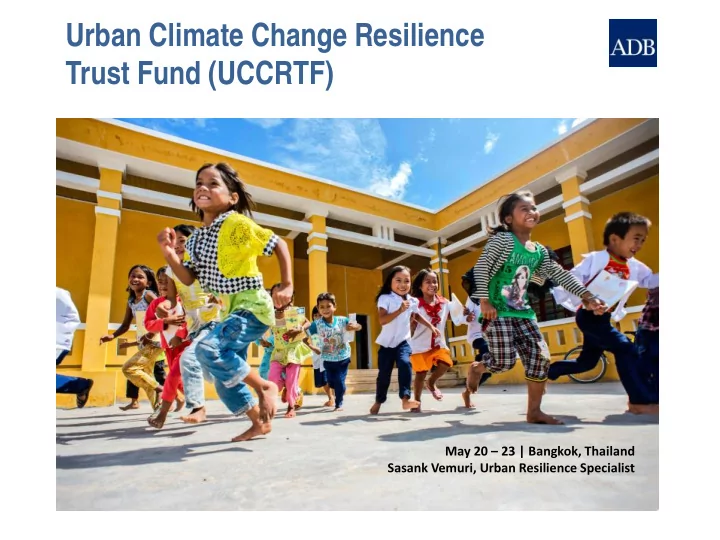

Urban Climate Change Resilience Trust Fund (UCCRTF) May 20 – 23 | Bangkok, Thailand Sasank Vemuri, Urban Resilience Specialist
2 Overview 1. What is UCCRTF 2. What have we achieved 3. What have we learned
Urban Climate Change Resilience Trust Fund (UCCRTF) What is UCCRTF: multi-donor Financing Partnership Partnership of ADB, Rockefeller Foundation, SECO, DFID • $135m in UCCRTF (2013-21) • UCCRTF will invest funds in 3 Components: 1. Planning: integrating cc and disaster risk planning in city plans and build capacity of stakeholders and city actors (20%) 2. Investment: Soft investments on city institutional capacity, project preparation and financial closure of infrastructure investments (70%) 3. Knowledge: Peer to peer learning and M&E (10%)
High-level Objectives
Conceptualizing Urban Resilience to Climate Change 1 Maintaining Essential Urban Functions Actions to build resilience should respond to three key questions. Urban Urban poverty climate risk URBAN 1. How does the city work (the urban systems)? reduction management SYSTEMS 2. What are direct and indirect impacts of climate change (climate change)? 3. Who is least able to respond to shocks and stresses (vulnerable groups)? VULNERABLE CLIMATE GROUPS CHANGE Figure 1 highlights that the action focusing on disaster risk reduction and/or urban poverty reduction 3 2 Disaster is necessary but insufficient to maintain urban functions in risk reduction the face of direct and indirect climate change impacts. Who is least able What are the direct Direct Indirect 1 How does the city work? 2 to respond to shocks 3 and indirect impacts Impact Impact and stresses? of climate change? Figure 1: Conceptualizing Urban Resilience to Climate Change Source: Da Silva, et al. 2012
ADB UCCRTF Project Design Criteria 1. Support resilience of poor and 5. Incorporate training or programming vulnerable that helps build awareness of risks 2. Address interdependent shocks 6. Create minimal environmental and stresses impacts and no physical or economic displacement 3. Reduce costs due to the effects of climate change 7. Respond to the seven resilience characteristics of UCCR 4. Involve diverse stakeholders in a cross-sector planning process and 8. Align with other ADB projects be led by community members
Seven qualities frame how we understand the resilience of a system and the solutions that aim to address vulnerability Reflective Flexible Robust Inclusive Integrated Resourceful Redundant 7
UCCRTF Project Portfolio
UCCRTF Climate Risks Pluvial Flooding 25 Extreme Heat Coastal Flooding 20 15 Tidal Surge Fluvial Flooding 10 5 Increased Precipitation Salinity 0 Storm Surges Coastal Erosion Landslides Sea-level Rise Droughts Typhoons
Achievements to Date 2.2 Million 3 Resilience on the 9 Non-physical measures negative effects of to 1,484,242 2016 climate change 27 enhance UCCR are 40 2017 1,800,000 implemented in cities 2016 4 Value of ADB urban 12 Infrastructure projects receive sector lending URF support incorporates 2016 2017 UCCR principles 14 19 20 2016 22 17 11 6 Cities include UCCR principles in local government strategies 13 $1 billion in UCCR-related through multisectoral and 2016 Loan or projects mobilized, inclusive planning $1.8B including 2017 14 processes 20 $1B at least $200 million $750M in non-Loan Amount.
UCCRTF’s Work on Data
12 Lessons Learned Planning for resilience does not automatically lead to resilience enhancing • projects. Good data is not enough for good projects • Relying solely on climate-science based risk assessments is not sufficient to • ensure that infrastructure projects increase the resilience of the most vulnerable communities. Identifying and implementing community-led interventions does not • generally emerge automatically from infrastructure planning processes. Communicating resilience is extremely challanging •
Thank you Thank You
Recommend
More recommend